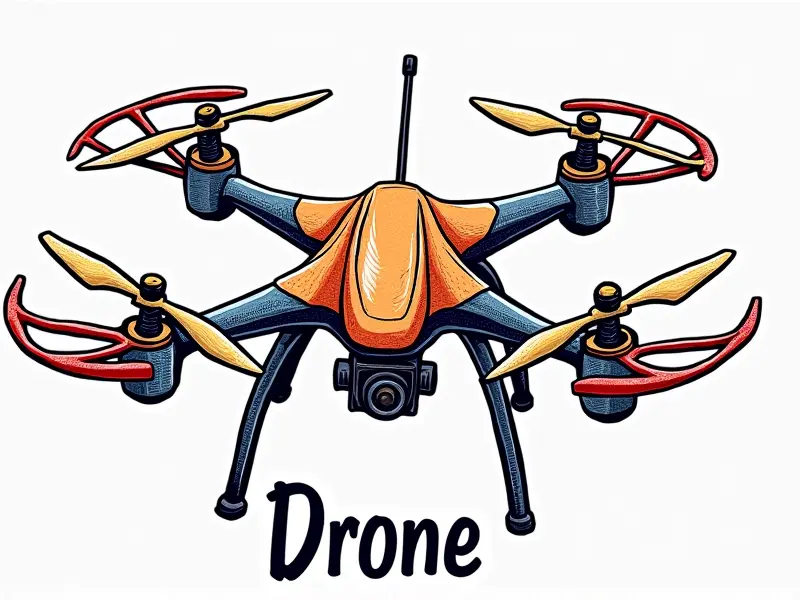FPV drone antennas types

Understanding Polarization in FPV Antennas
Polarization is a critical aspect of FPV drone antennas that significantly affects signal quality and range. It refers to the orientation of electromagnetic waves as they travel through space, which can be either horizontal, vertical, or circular (left-hand or right-hand). Proper polarization ensures maximum signal strength by aligning the transmitting antenna's wave pattern with the receiving antenna.
Horizontal polarization is common in consumer electronics like smartphones and Wi-Fi routers due to its ease of implementation. However, for FPV drones, vertical polarization is often preferred because it reduces interference from ground-based signals and provides a more consistent signal when the drone is flying vertically or at an angle.
Maximize Range with FPV Drone Antennas
To achieve maximum range in your FPV drone setup, selecting the right antenna type is crucial. Gain antennas are designed to focus the RF energy into a narrower beamwidth, concentrating more signal power towards specific directions. This results in better penetration through obstacles and increased distance.
- Directional Antennas: These include Yagi and patch antennas that offer high gain but limited coverage angles. They are ideal for long-distance flights where maintaining a direct line of sight is possible.
- Omnidirectional Antennas: These provide 360-degree coverage, making them suitable for shorter-range applications or when the drone's flight path is unpredictable.
Boost Your FPV Signal with These Antenna Options
Selecting the right antenna can dramatically improve your FPV experience. Here are some popular options:
- Patch Antennas: Known for their high gain and narrow beamwidth, patch antennas like the 5GHz Patch offer superior performance in long-range scenarios.
- Yagi Antennas: These directional antennas provide excellent range but require precise alignment between transmitter and receiver. They are commonly used by FPV racers for their high gain capabilities.
- Slimline Antennas: Slimline designs, such as the 2.4GHz Slimline, offer a balance of compact size and moderate gain, making them versatile for various drone setups.
Top 5 FPV Drone Antennas for Distance
If you're looking to push your FPV range to its limits, consider these top-performing antennas:
- 4-Element Yagi: With a gain of around 8dBi, this antenna delivers exceptional long-range performance.
- 5GHz Patch Antenna: Offering up to 12dBi gain, it's perfect for high-frequency applications and extended range.
- Mushroom Antenna: This omnidirectional design provides a wide coverage area with moderate gain, ideal for mixed-range flights.
- Slimline Antennas (2.4GHz): These compact antennas deliver good performance in both short and medium ranges.
- Corner Reflector: Known for its high gain and directional focus, this antenna is excellent for long-distance FPV flights.
DIY FPV Drone Antenna Solutions
For those interested in customizing their FPV setup, building your own antennas can be both cost-effective and rewarding. Here are a few DIY options:
- Simple Dipole Design: A basic dipole antenna can be constructed using simple materials like coax cable and wire.
- Parasitic Elements: Adding parasitic elements to your design can increase gain, similar to how a Yagi antenna works.
- Magnetic Mounts: Creating magnetic mounts allows for easy attachment and removal of antennas from metal surfaces like drone frames or vehicles.
FPV Drone Antenna Guide for Beginners
For newcomers to FPV drones, understanding the basics is essential. Start with simple omnidirectional antennas before moving on to more complex directional designs:
- Omnidirectional Antennas: Great for learning and short-range flights.
- Broadband Antennas: Offer a compromise between range and coverage, suitable for intermediate users.
Compare Different Types of FPV Antennas
Different antenna types have unique characteristics that suit various flying conditions. Here’s how they stack up against each other:
- Patch vs Yagi: Patch antennas offer higher gain but are less directional compared to Yagis.
- Slimline vs Mushroom: Slimlines provide better range, while Mushrooms give wider coverage at the expense of some gain.
Essential FPV Antennas for Racing Drones
Racing drones require antennas that can handle high speeds and tight turns without losing signal. Consider these options:
- High-Gain Yagi: Ensures a clear, uninterrupted signal even at high speeds.
- Mushroom Antenna: Provides reliable omnidirectional coverage for unpredictable flight paths.
Understanding Gain vs Bandwidth in FPV Antennas
The terms "gain" and "bandwidth" are crucial when choosing the right antenna. Gain refers to how much signal strength is amplified, while bandwidth indicates the frequency range over which an antenna operates effectively.
- High Gain: Better for long-range applications but may reduce overall bandwidth.
- Broad Bandwidth: Suitable for maintaining a stable connection across various frequencies.
Common Mistakes with FPV Drone Antennas
Avoid these common pitfalls to ensure optimal performance:
- Mismatched Polarization: Ensure both transmitter and receiver antennas are properly aligned for polarization.
- Inadequate Ground Plane: A well-designed ground plane is essential for omnidirectional antennas to perform correctly.
FPV Drone Antenna Compatibility Guide
When selecting an antenna, consider compatibility with your drone and transmitter. Check the following:
- Frequency Band: Ensure the antenna matches the frequency band of your FPV system (e.g., 5GHz).
- Connector Type: Verify that the connector on the antenna fits with your drone's feedline.
Conclusion
Selecting the right FPV drone antennas is crucial for enhancing signal quality and range. By understanding polarization, choosing between directional and omnidirectional options, and avoiding common mistakes, you can significantly improve your FPV experience. Whether you're a beginner or an experienced racer, there's always room to optimize your setup with the right antenna choices.

